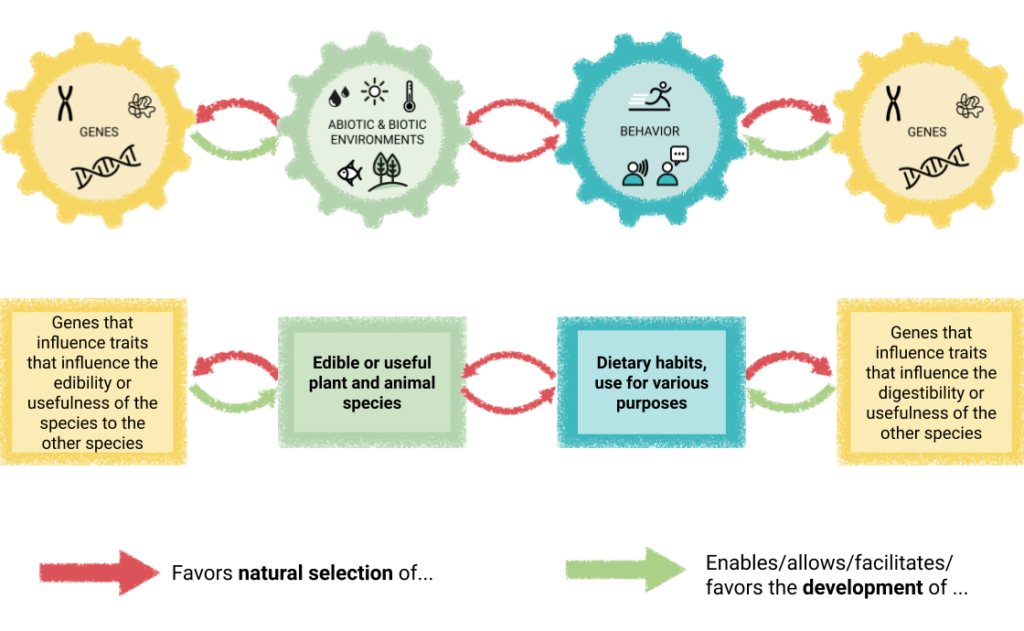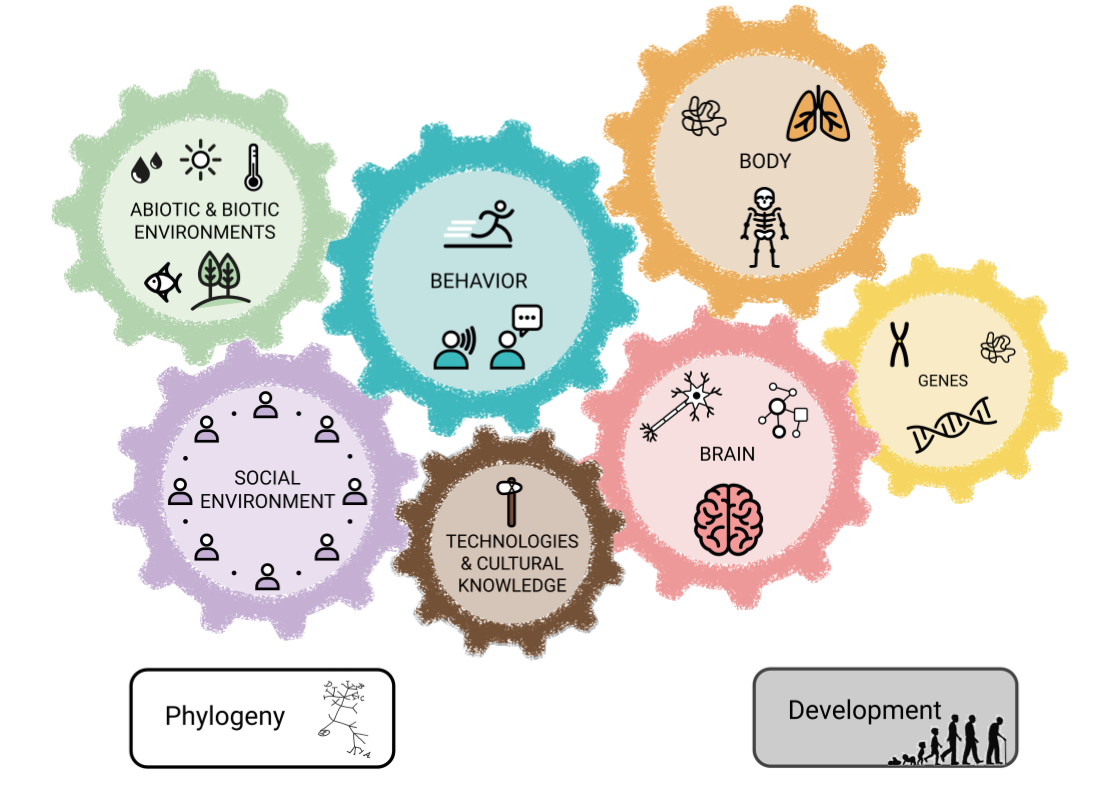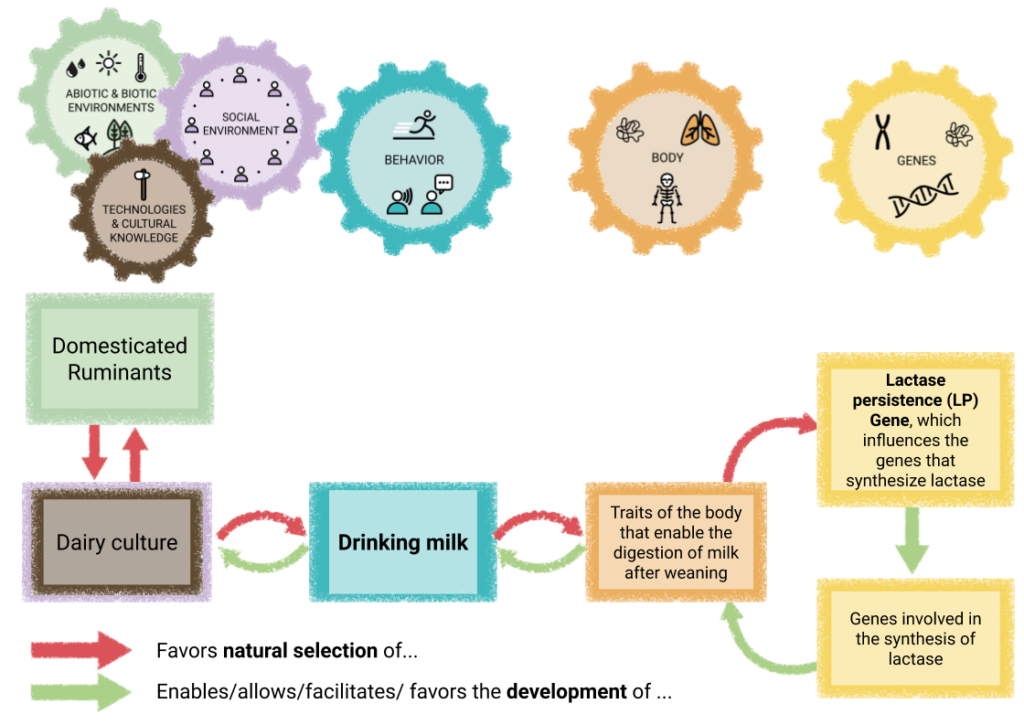Agriculture and domestication
For most of our evolutionary history, our species fed on the hunting and gathering of animals and plants in the environment. An innovation with far-reaching consequences was the “invention” of agriculture.
Agriculture is a kind of co-evolution or symbiosis of humans and other living things: certain plant and animal species that were present in the environment were favored by humans for food, processed for clothing, tools and other purposes, or animals were used for protection and work. This preferential use of certain species has led people to preferentially treat, feed or protect these species, or lead to the accumulation and multiplication of seeds and germinating plant parts of used plant species in their environment. So began the domestication – the natural selection of living things, in which the human is a selection factor (also called “artificial selection”, especially in recent times, when selection of traits is done through intentional scientific breeding programs).
This coevolution transformed genes from domesticated plant and animal species as well as humans. This is because agriculture changed the diet of people, who adapted to this diet through biological evolution. One third of people today have a lactose tolerance, i. e. they can digest milk and dairy products in adulthood. These are mainly people who come from regions where animal husbandry and dairy processing have a long history.

Co-evolution between species: a relationship in which one species influences the chances of survival and reproduction of the other species, and vice versa. Thus, in both species, traits can arise through natural selection that make them interdependent.

Causal maps on the evolution of human traits
All causal maps on human evolution in one Google slide file
Example: lactose tolerance

The evolution of lactose tolerance is an example of gene-culture co-evolution
External resources in English from HHMI Biointeractive

Humans are not the only species that have entered into such a symbiosis with other species. In addition to humans, some insect species also breed and cultivate other species: e.g. leafcutter ants, which have been cultivating and growing certain strains of fungi in their nests for 50 million years. The ants depend on these cultivated fungal strains because they are their only food source. In turn, the fungal strains are dependent on the ants, because they enjoy an environment prepared for them by the ants, in which they are protected from competition with other fungal strains.
The domestication of species is thus not necessarily bound to any particular “intelligence” or “conscious intention.” So we can imagine that even the beginning of domestication by humans was not necessarily the result of a conscious intention of some individuals. Rather, it probably arose from an interaction between humans and other species in their biological environment, which over many generations led species to mutually influence their evolution and eventually coexist in a permanent interdependent ecological relationship.


Leafcutter ants in their “fungus garden”. Image source: Christian R. Linder, Creative Commons Attribution-Share Alike 3.0 Unported license.
The fungus gardens of leafcutter ants (Wikipedia)
Cossins, D. (2015). Amazing animal farmers that grow their own food. BBC
Teaching material: Comparing the “agriculture” of humans and leaf-cutter ants (in preparation)
Compared to the fungus cultivation of leafcutter ants, human agriculture is very young – it originated around 10,000 to 4,000 years ago in parallel in several regions of the world. Through the co-evolution of humans and domesticated species, more food, and more nutritious food, has been extracted from the environment than by hunting and gathering “wild” species whose evolution has not been influenced by interrelation with humans. Thus, the feeding of our population has increasingly become dependent on agriculture.
Agriculture contributed significantly to an increase in group sizes and an increase in the total population of our species. In addition, food could or had to be stocked increasingly, and domesticated animals had to be cared for. All of this had an impact on the social organization of our species: a shift to sedentary lifestyles, wealth accumulation, the formation of hierarchies in human groups, the ability to steal accumulated supplies and possessions from others by force, and the need to protect accumulated possessions from others.
Approximate centers of origin of agriculture. Image source: Joe Roe, CC BY-SA 3.0
Approximate centers of origin of agriculture: the Fertile Crescent (11,000 BP), the Yangtze and Yellow River basins (9,000 BP) and the New Guinea Highlands (9,000–6,000 BP), Central Mexico (5,000–4,000 BP), Northern South America (5,000–4,000 BP), sub-Saharan Africa (5,000–4,000 BP, exact location unknown), eastern North America (4,000–3,000 BP)
Domestication of dogs and other pets
Possbile discussion questions about the video:
- Which characteristics were selected or were of interest in the breeding of foxes (and also dogs), which were not?
- What does “hyper-sociability” mean? What behaviors does it involve?
- Describe the simple experiment breeders used in order to evaluate the sociability of dogs, foxes, and other domesticated animals.
- Is tame and friendly temperament determined only by inherited genes? If not, by what other factors?
- Why can geneticists use bred foxes rather than bred dogs to better study the genetics underlying a tame, friendly temperament?
- What external characteristics/body features are associated with domestication in addition to social temperament?


